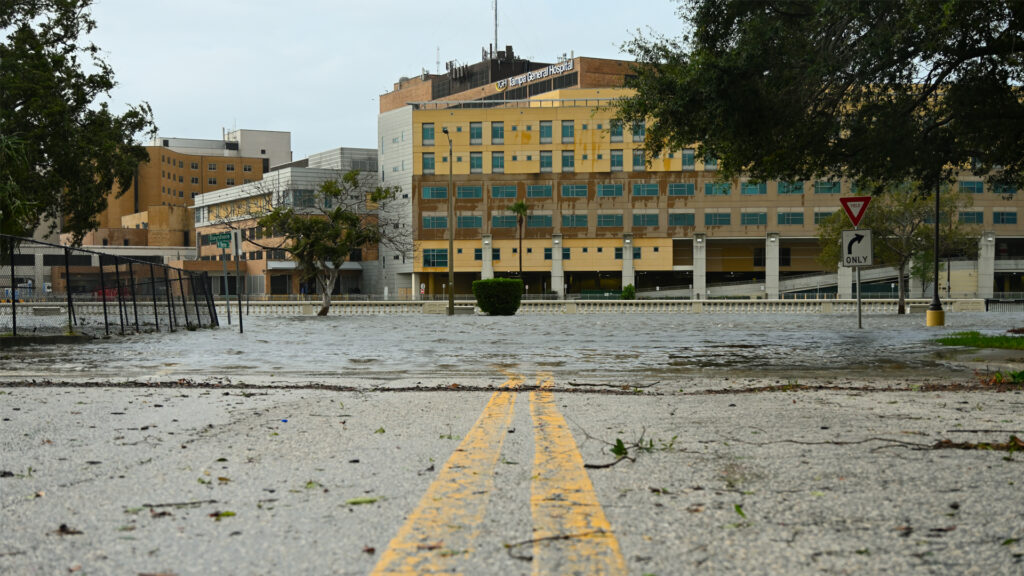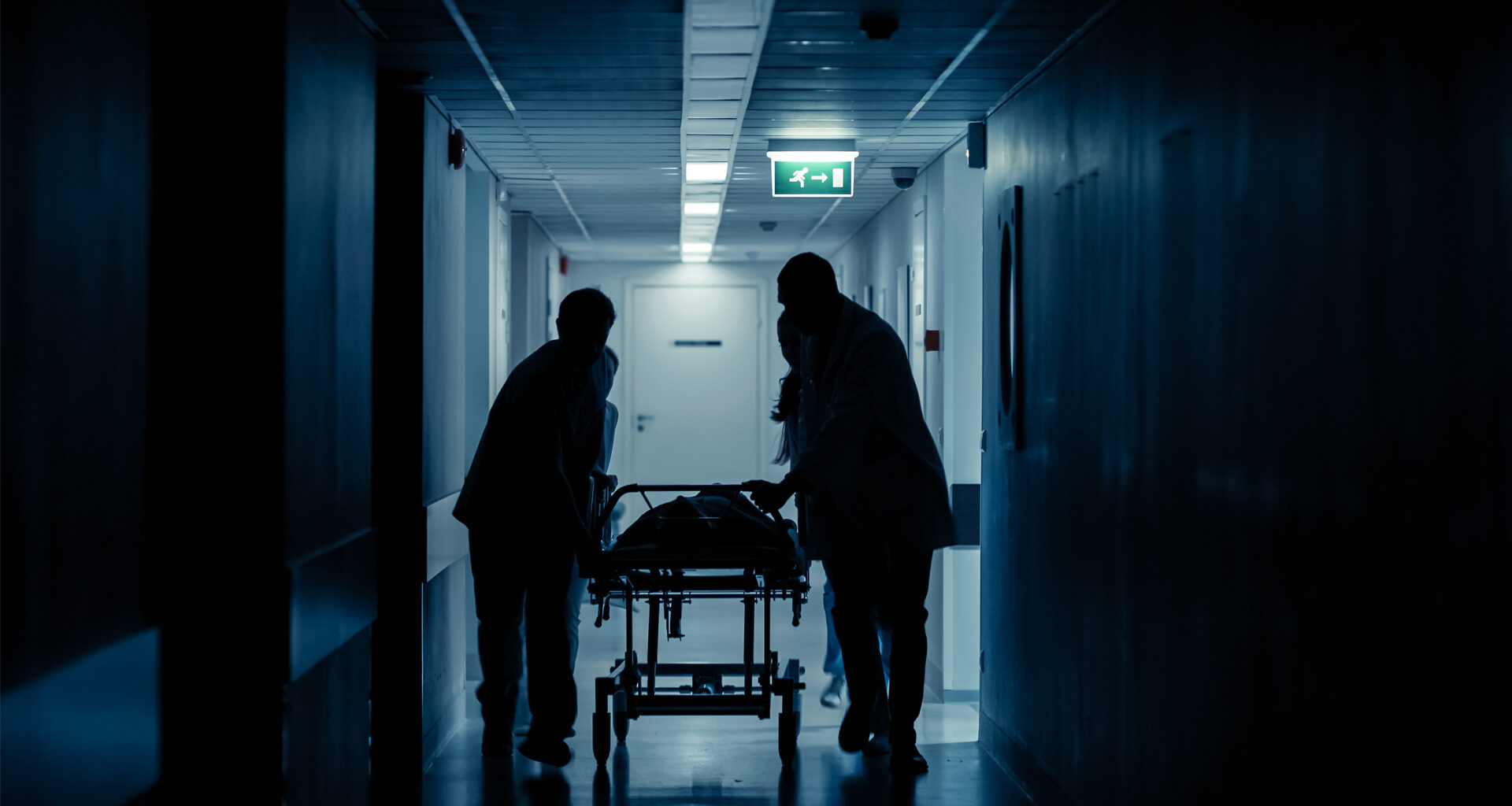By Julie Moyle, Practice Greenhealth
Florida’s hospitals have experienced hurricanes, flooding and even cyberattacks on the power grid that serves them. In each case, maintaining patient safety depends on one thing above all: reliable electricity. Without it, critical services provided in emergency rooms, operating suites and intensive care units are compromised. For Florida’s health care system, power is not a convenience; it is essential to caring for 23 million Floridians.
As a nurse, I am familiar with how even brief power disruptions can endanger patients, and how prolonged outages can further strain already thin margins. That’s why the strength of Florida’s electric grid isn’t just about infrastructure; it’s about keeping people safe, hospitals operational and communities secure.
 Storm surge from Hurricane Idalia caused flooding in Tampa in 2022, including in the area around Tampa General Hospital. (Andrew Heneen, CC BY 4.0, via Wikimedia Commons)
Storm surge from Hurricane Idalia caused flooding in Tampa in 2022, including in the area around Tampa General Hospital. (Andrew Heneen, CC BY 4.0, via Wikimedia Commons)
Over the past decade, millions of Floridians have lost power during major storms. Hurricane Irma in 2017 left more than six million people in the dark, while Hurricane Ian in 2022 cut power for 2.6 million more. We’re seeing similar challenges now in Jamaica, where Hurricane Melissa has caused power loss and hospital damage this week, complicating response efforts. When outages are not addressed in a timely fashion, the risks multiply: surgeries delayed, medications spoiled, seniors trapped in overheating dwellings and hospitals forced to operate on limited diesel generator backup systems.
Reliability isn’t the only concern; affordability matters too. Rate increases currently under consideration could add roughly $180,000 a year in electricity costs for each individual hospital in Florida by 2029, according to testimony filed with the Florida Public Service Commission, and residential rates are set to increase 2% per year for the next four years. These cost increases will ripple through the health system, stretching hospital budgets, impacting patients’ wallets and ultimately raising the cost of care.
Meanwhile, demand for power inside hospitals keeps climbing. Lifesaving technologies and around-the-clock cooling, essential in Florida’s record-breaking heat and humidity, require more electricity than ever. Without smarter grid planning, rising costs will leave hospitals and families more vulnerable.
Florida has earned a reputation for strong electricity reliability under normal conditions, as well as proactive power-crew staging and mapping of critical sites before major storms. However, as storms become more severe, temperatures rise and demand increases, that reliability is under threat.
The good news is that Florida has tools to strengthen its grid and protect both people and the economy. But as energy markets shift, policymakers must take a more active role in addressing growing risks like those from price volatility and aging infrastructure. Solutions like energy efficiency, increased battery storage with geothermal and solar technologies, and microgrids can make the system more resilient, keeping hospitals, water systems and other critical facilities online even when the broader grid goes down. Consumer advocates such as AARP have called for grid reforms that prioritize affordability, transparency and reliability. These principles should guide Florida’s energy decisions moving forward.
Policymakers should focus on solutions that are practical and resilient. Florida currently relies on natural gas for 75% of its electricity, nearly all of it imported, leaving the state vulnerable to additional price increases and supply disruptions. Diversifying energy sources would reduce that risk while maintaining reliability. At the same time, investing in energy efficiency lowers bills, eases stress on the grid, especially during peak demand, and can extend the period of time hospitals remain operational when primary power is lost. Expanding local non-fossil energy resources will help hospitals stay online when it matters most.
 Julie Moyle
Julie Moyle
These are not abstract ideas. Other states are already deploying microgrids in vulnerable communities, setting ambitious energy efficiency goals and using new technologies to get more out of existing power lines. Together, these approaches have improved reliability, reduced costs and made communities more resilient in the face of rising demand and extreme weather.
Florida’s hospitals are one of the state’s most critical service sectors, employing hundreds of thousands and caring for millions more. A resilient, affordable grid helps hospitals keep Floridians healthy and supports the state’s economy.
Hospital personnel know from experience that prevention is always more effective and cost-efficient than crisis response. The same principle applies to Florida’s energy system. Florida’s leaders should adopt a comprehensive plan that strengthens the grid, contains long-term costs and prioritizes the health and safety of every single resident. Because in the end, energy security is health security.
Julie Moyle, MSN, RN, is a nurse and Florida hospital solutions manager with Practice Greenhealth, an organization dedicated to helping hospitals improve energy reliability, efficiency and cost management while strengthening community health and resilience. Banner photo: Hospital staff bring a patient on a gurney (iStock image).
Sign up for The Invading Sea newsletter by visiting here. To support The Invading Sea, click here to make a donation. If you are interested in submitting an opinion piece to The Invading Sea, email Editor Nathan Crabbe at ncrabbe@fau.edu.

